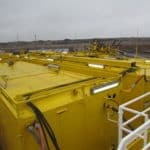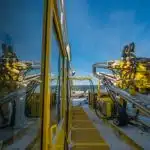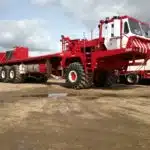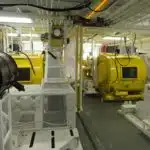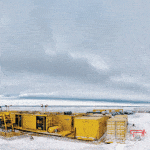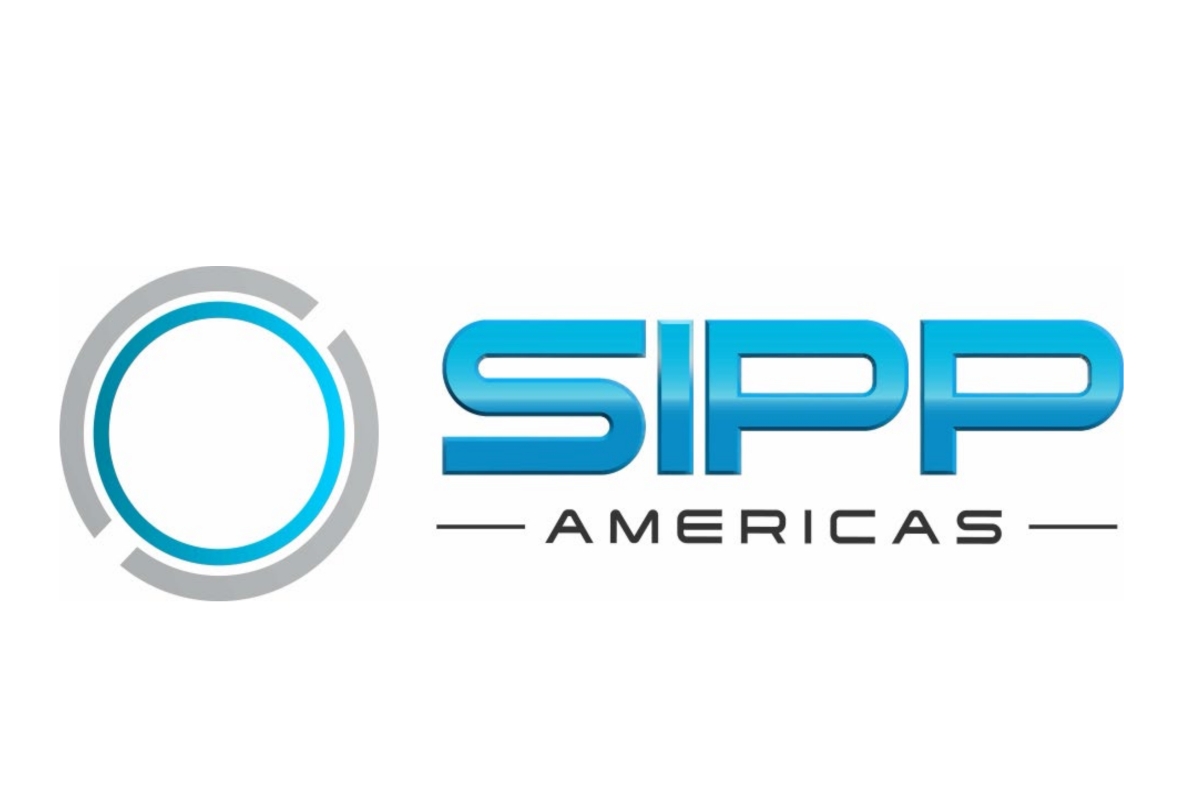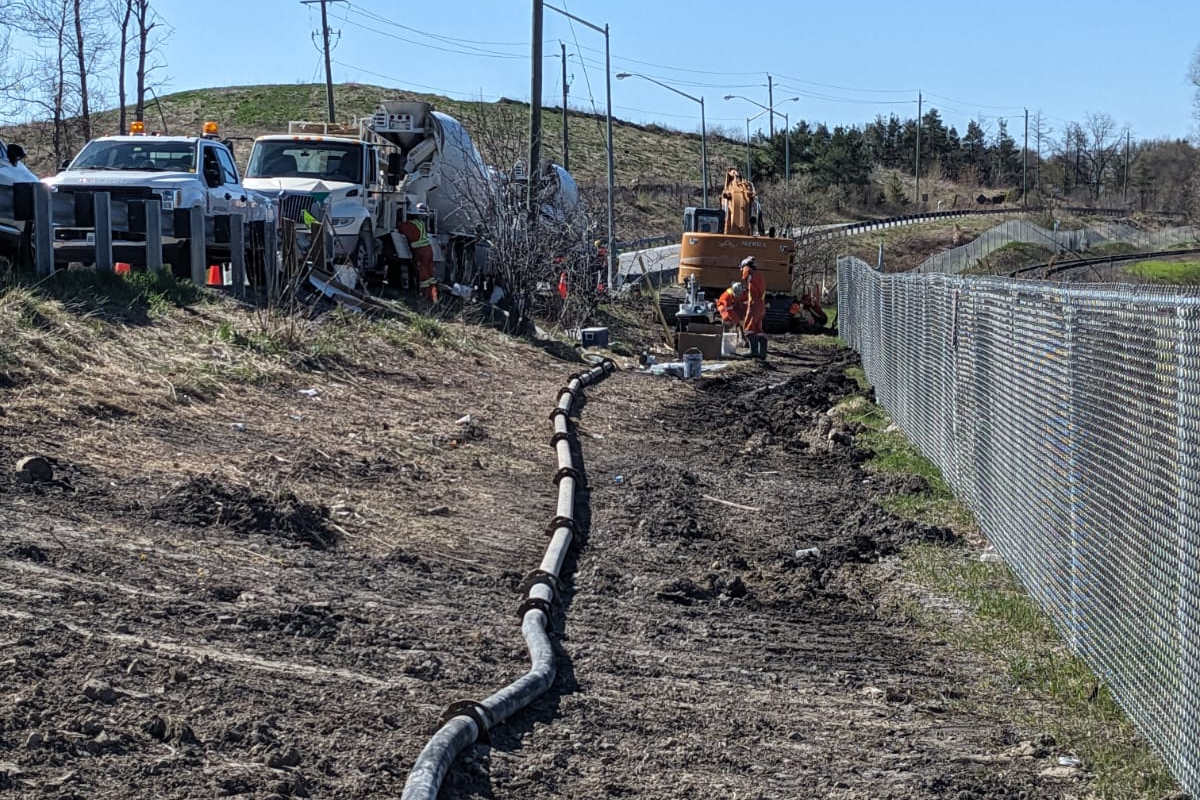
Experienced Staff, High-Quality Equipment Play Vital Role in Direct Horizontal’s Success
- Direct Horizontal Drilling has grown from four rigs in 2009 to 19 rigs.
- Direct Horizontal Drilling’s HDD rigs are augmented by equipment built in-house.
- Just a really cool photo of a Direct Horizontal Drilling rig at work during the winter.
- Thanks to sister companies like Northwell Oilfield Hauling, Direct Horizontal Drilling can easily move its skid-mounted equipment across the country and through a variety of weather conditions.
- An inside look at Direct Horizontal’s equipment.
- The Strait of Belle Isle project had Direct Horizontal’s crews working in all four seasons.
- Not all of the Strait of Belle Isle project was done in the cold. Direct Horizontal’s equipment is uniquely modified to work through all of Canada’s seasons without stopping.
When discussing horizontal directional drilling (HDD) in Canada, a handful of companies quickly come to mind and one of those at the top of the list is Direct Horizontal Drilling.
The company, headquartered in Edmonton, formed in 2001 and experienced a boom in its growth in 2009 when Canadian oilfield veteran and lifelong entrepreneur Neil Brown purchased the company.
At that time, Direct Horizontal had a fleet of four HDD rigs, but Brown had a vision to grow the company — using nearly a half-century’s worth of oil and gas industry experience — into one of the tops in the HDD industry. With the help of Lon Briscoe, who joined the company in 2010 as president, and Brian Sadoway, in 2012 as vice president, the company blossomed to 18 rigs in six years. Two of those rigs are the largest in Canada.
“We grew as the work dictated and we saw what we needed to do to expand,” Briscoe explains. “In my time here, it’s the people and equipment that have helped make us who we are. We hire experienced, high-performance drilling professionals and have a high performance fleet.”

Direct Horizontal prides itself on having the highest performing equipment and employees in the HDD industry. The company employs 50 workers full-time, that number blossoms to 250 during the busy season, and many are oil and gas industry veterans.
The Direct Team
Those high performance people include Briscoe, who has 42 years of HDD and oil and gas experience and Sadoway, who has 49 years of drilling experience. Direct Horizontal employs 50 workers full-time, that number increases to 250 during the busy season, and many, like Briscoe and Sadoway are oil and gas industry veterans.
RELATED: Legends of HDD Scores Big at 2013 No-Dig Show
As for the fleet, it consists of 10 American Augers rigs and eight Ditch Witch HDD rigs. Per Brown’s vision for the company, Direct Horizontal updates the rigs in-house to make them the best and safest rigs in use in Canada. All of the ancillary equipment is custom-built by Direct Horizontal to match the rigs and the working conditions in Canada. Translation: The maxi-rigs are at home drilling when the temperatures are at -45 C.
“For us, this is every day, business as usual. For other people, it’s not,” Briscoe says. “When people come up here, I explain it like this, ‘Our rigs are purpose-built for these conditions in Canada. I can’t take one of my million-pound rigs, go to Texas and compete down there. It just would not work.’”
The unitized drilling system’s design is such that Direct Horizontal’s maxi rigs can be rigged up and ready to drill within 24 hours. [See the sidebar at the end of this story for a glimpse at some of the equipment on a typical Direct Horizontal jobsite.]
RELATED: Directional Drilling in the Oilsands in Alberta
A trio of support companies aid in moving an operation of this magnitude — more than 30 truckloads of equipment for its largest rig — and keeping the systems humming all across Canada. Terra Core Rentals Ltd., Northwell Oilfield Hauling and Pentastar Air Ltd. are sister companies to Direct Horizontal, all owned by Brown.
Northwell operates more than 100 oilfield rig moving trucks and specialty vehicles in Alberta and British Columbia.
“It’s a whole different type of drilling up here. Everything is heavy skid-mounted. We don’t have wheels of any kind,” Briscoe says. “The places we work, cranes are not available. Typically, a lot of rigs are set up with cranes, ours are set up with specialty rig moving equipment that is designed for drilling rigs in Alberta.”
Pentastar Air, a private aviation company, operates three planes, which move crews for all of Brown’s companies to jobsites across Canada.
This mobility and top-notch fleet helped the company secure one of its biggest, most difficult and most lucrative contracts in its 15-year history — the Nalcor Energy Strait of Belle Isle marine cable crossing.
The project received recognition as Trenchless Technology’s 2015 Project of the Year new installation runner-up.
“The Nalcor project is an $8.5 billion project that went out to the world, Europe, the U.S.A. and Canada and we won it,” Briscoe says. “We probably spent about three to four months planning the project, running on-paper drilling programs with Nalcor, who are experienced offshore drilling people.”
REALTED: 2015 Trenchless Technology Project of The Year — News Installation
Briscoe adds, “Like us, they know what they are talking about. They know the equipment and they think about the science down hole. They think of annular velocity, how much are we pumping and how much and how fast we are cleaning the hole. That is the way drilling engineers think, and that is the way we think. That made this [project] a good fit.”

Direct Horizontal Drilling has built a reputation as one the top HDD companies in Canada. Though it buys its rigs from American Augers and Ditch Witch, the ancillary equipment is built in-house to custom specs.
On the Isle
Nalcor Energy is Newfoundland and Labrador’s energy company and is focused on sustainable development of the province’s energy resources. One of its key projects is the Muskrat Falls Project in Labrador, one of the most attractive, undeveloped hydroelectric sites in North America.
The Muskrat Falls hydroelectric development on the lower Churchill River will provide a clean, renewable source of electricity, provide homes and businesses with stable electricity rates and will be a valuable power-producing asset for the province well into the future.
The project includes construction of an 824 megawatt (MW) hydroelectric dam on the lower Churchill River in Labrador, and more than 1,500 km of transmission lines and associated infrastructure that will deliver electricity to homes and businesses in Newfoundland and Labrador. The hydroelectric facility consists of two dams and a powerhouse, and will be the second-largest hydroelectric facility in the province when complete.
Power generated at Muskrat Falls will be delivered to homes and businesses on the island of Newfoundland via an 1,100 km High Voltage direct current (HVdc) transmission line running from Muskrat Falls in central Labrador to the Avalon Peninsula in eastern Newfoundland.
To connect the transmission line from Labrador to Newfoundland, a 35-km marine cable crossing is being constructed across the Strait of Belle Isle, from Forteau Point, Labrador to Shoal Cove, on the island of Newfoundland.
The marine cable crossing included the installation and operation of three marine power cables along the seabed across the Strait of Belle Isle. Using a unique approach to HDD technology, drill rigs bored three holes for the transmission cables from the shoreline and out under the seabed at a depth of 70 m to safely avoid potential interaction of the cable with the dozens of icebergs that drift into the Strait of Belle Isle each year.
The HDD program in the Strait of Belle Isle was successfully carried out between December 2013 and October 2014. Each borehole was approximately 1.25 to 2 km long on both sides of the Straits, marking the longest HDD landfall application in the world.
“We got to experience all of the seasons, Briscoe jokes. “It was horrible, horrible, tough weather, with winds up to 120 kmh and freezing conditions. It also required multiple rigs moves (12 rig moves total, including three barge movements), which meant barging the rigs.
Here are a few of the factors that made this project so outstanding:
• Saved $10 million in project costs
• Smooth bores to enable world-record breaking cable pull-in length
• Precisely placed bores in iceberg laden waters
• 10,000 m drilled through hard rock
• Less than 2 percent downtime in extremely harsh conditions

From left, Biran Sadoway, vice president operations, Neil Brown, chairman, and Lon Briscoe, president, have helped Direct Horizontal Drilling grow to become one of the leaders in Canadian HDD.
Implementing the best HDD technologies while incorporating oilfield drilling technologies and methods proved instrumental for drilling the world’s longest horizontal boreholes drilled from land into the ocean: three on the island averaging 2,100 m each, and three in Labrador averaging 1,200 m each, for a total installed conduit length of 9,950 m.
Six conduits were installed to protect the shore approach for subsea HVdc cables that are required for completion of the 1,100 km transmission line, part of the Muskrat Falls hydroelectric project in Newfoundland and Labrador.
Throughout the HDD program, the main objective was to provide the best conduits to minimize risk of damage to the cables during pull-in from the ocean, while keeping within the following constraints:
• Not to exceed 50 m below the seabed
• 75 m water depth targets at Forteau exits
• 70 m water depth at Shoal Cove exits
• Exit angles between 3 and 17 degrees
• Not to exceed 2,200 m length for all conduits
• Path drilled as straight and smooth as possible
Precise borehole placement along with minimal tortuosity and good borehole quality were critical for achieving smooth boreholes into which steel conduits could be inserted for the end result — installation of the subsea cable with the lowest possible pull-in tension.
This project successfully utilized multiple contractors across industry sectors, getting the job right the first time using atypical HDD methods. Although unconventional, the innovative approach to HDD in the Strait of Belle Isle worked very well given the geological conditions in the area and the difficulties encountered in pushing casing out of the seabed.
The Strait of Belle Isle marine cable crossing has pushed the boundaries of conventional HDD applications and identified innovative uses for traditional offshore techniques to develop a tailor-made solution for a challenging northern environment.
With the first phase of the project under its belt, Briscoe says that Direct Horizontal has a letter of intent in place to begin work on Phase 2 on April 1, 2016. That portion of the project involves two holes in Newfoundland and two in Nova Scotia to get power from Newfoundland to Nova Scotia. From there, Nalcor will also be able to sell its products to Maine.
The Nalcor project, like every project Direct Horizontal performs, from oil and gas to utility work and involving maxi rigs or its light rigs, boils down to the team. With its experienced staff, Direct Horizontal boasts more than 400 years’ worth of drilling management experience.
“Proper planning is the key. You need experienced, high performance people — from the team in the office to the team in the field — and high performance equipment,” Briscoe says. Adding that the company’s experience means Direct Horizontal is capable of drilling any size, any length and anywhere.

Mike Kezdi is assistant editor at Trenchless Technology Canada.


